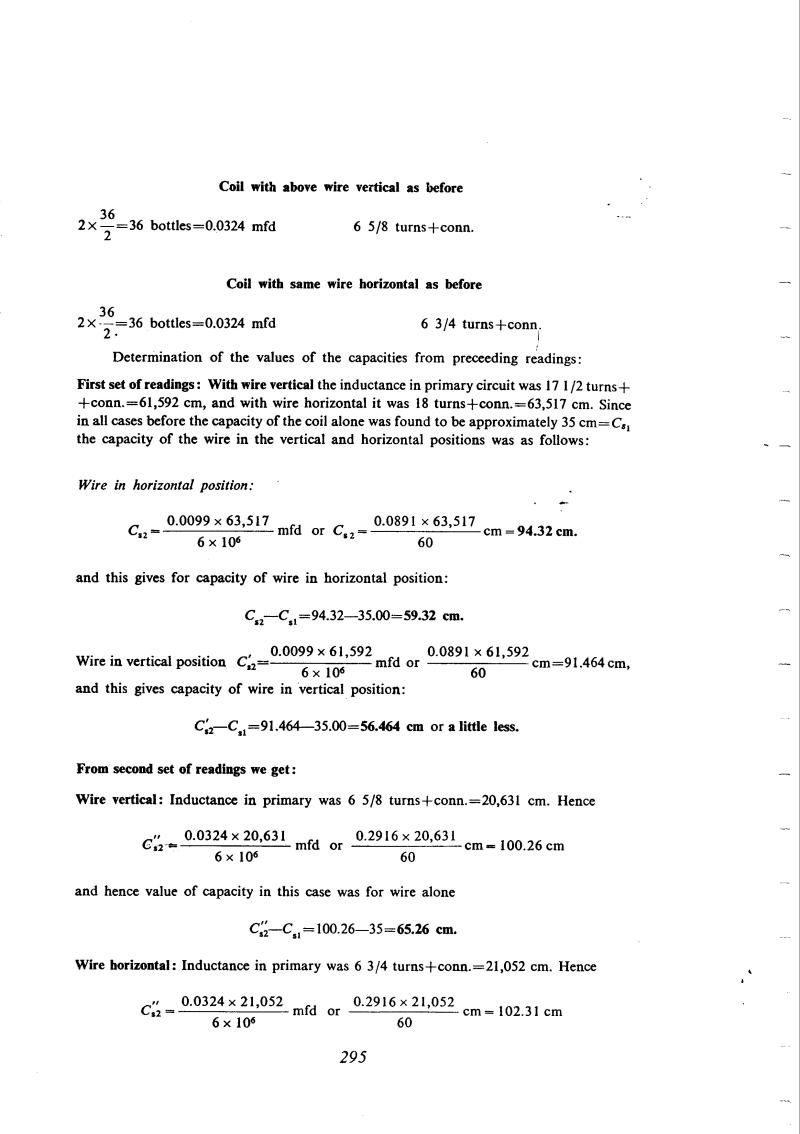
Nikola Tesla Books
| Coil with above wire vertical as before | |
| Capacity primary | Inductance primary |
| $! {{2 \times 36} \over 2} $! = 36 bottles = 0.0324 mfd | 6 5/8 turns + conn. |
| Coil with same wire horizontal as before | |
| $! {{2 \times 36} \over 2} $! = 36 bottles = 0.0324 mfd | 6 3/4 turns + conn. |
Determination of the values of the capacities from preceeding readings:
First set of readings: With wire vertical the inductance in primary circuit was 17 1/2 turns + conn. = 61,592 cm, and with wire horizontal it was 18 turns + conn. = 63,517 cm. Since in all cases before the capacity of the coil alone was found to be approximately 35 cm = Cs1 the capacity of the wire in the vertical and horizontal positions was as follows:
Wire in horizontal position:
Cs2 = $! {{0.0099 \times 63,517} \over {6 \times 10^{6}}} $! mfd or Cs2 = $! {{0.0891 \times 63,517} \over 60} $! cm = 94.32 cm.
and this gives for capacity of wire in horizontal position:
Cs2 - Cs1 = 94.32 - 35.00 = 59.32 cm.
Wire in vertical position C's2 = $! {{0.0099 \times 61,592} \over {6 \times 10^{6}}} $! mfd or $! {{0.0891 \times 61,592} \over 60} $! cm = 91.464 cm, and this gives capacity of wire in vertical position:
C's2 - Cs1 = 91.464 - 35.00 = 56.464 cm or a little less.
From second set of readings we get:
Wire vertical: Inductance in primary was 6 5/8 turns + conn. = 20,631 cm. Hence
C''s2 = $! {{0.0324 \times 20,631} \over {6 \times 10^{6}}} $! mfd or $! {{0.2916 \times 20,631} \over 60} $! cm = 100.26 cm
and hence value of capacity in this case was for wire alone
C''s2 - Cs1 = 100.26 - 35 = 65.26 cm.
Wire horizontal: Inductance in primary was 6 3/4 turns + conn. = 21,052 cm. Hence
C''s2 = $! {{0.0324 \times 21,052} \over {6 \times 10^{6}}} $! mfd or $! {{0.2916 \times 21,052} \over 60} $! cm = 102.31 cm
295
November 21
For some reason which he does not explain, Tesla was interested in the capacity of the same wire when vertical and horizontal, which he measured by the usual resonance method, repeating it with a different capacitance in the primary as a check. Although the results from the two sets of measurements differ appreciably, the value obtained with the wire horizontal was somewhat higher in both cases. The formulae which Tesla used July 24th here yields 54.37 cm for the vertical wire and 58.43 cm for the horizontal. These values agree well with his measurements, especially the first set.
November 21
Tesla determines the capacitance of the same wirelength when it is positioned vertically and horizontally. The measurements were performed by the usual resonant method, and for the purpose of checking he repeated the measurements with two capacitance values in the primary. Although the measurement results in the two series are quite different, in both cases the obtained capacitance is somewhat larger for horizontally positioned wire. By the application of the equation Tesla used on November 16 he obtains the vertical wire capacitance as 54.37 cm. If for the purpose of calculating the electrostatic capacitance of a horizontal conductor the equation for a metal conductor above the metal plane is applied, 58.43 are obtained. When these results* are compared with Tesla's, particularly with the first measurement series, it could be seen that the match is satisfactory.
* The capacitance of a long conductor Tesla calculated on the basis of equation: Ch = $! {L \over 2ln {L \over R}} $! (cm) where L = conductor length in cm, and R = conductor radius in cm.
The thin conductor capacitance above a metal plane at the elevation h cm, and other dimensions as above, is given with(54): Ch = $! {L \over {2ln {2h \over R}}} $! (cm)

